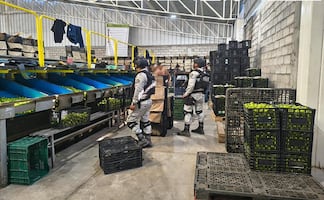Más Información

A 50 días del Plan Michoacán, detienen a 278 personas; realizan recorridos a empacadoras e industrias cítricas

Detienen y vinculan a proceso Alejandro Baruc “N” en Uruapan, Michoacán; podría estar relacionado con el asesinato de Carlos Manzo

Anticorrupción sanciona a tres empresas por proporcionar información falsa; les impide tener contratos con el Gobierno

"Más paz y seguridad para el 2026", pide presidente de la Conferencia del Episcopado Mexicano, Ramón Castro Castro
In recent years, Mexico has become a receiving country for Venezuelans, Central Americans, and members of the LGBT community, who flee their countries of origin due to violence, food and medicine shortages, and discrimination, according to Mark Manly , representative of the United Nations High Commissioner for Refugees (UNHCR) in Mexico.
During an interview with EL UNIVERSAL and to commemorate World Refugee Day , Manly stated that in 2017, 14,596 people applied for asylum in Mexico requesting refugee status, a figure which has increased 1,026%. In 2013, there were 296 cases and in 2017, 14, 596.
Manly explains that “there has been an important change at a regional level” with over 1.5 million Venezuelans who have left their country and 4, 042 who requested refugee status, to the extent Venezuela became last year the second country with the most citizens requesting refugee status in Mexico.
Who are the asylum seekers?
“According to Mexican laws, there are two definitions of refugee. The global, which is the one we apply in the United Nations, that states the individual has to demonstrate there is a well-founded fear of becoming a victim of a severe human rights violation, which is called persecution . Now, this [persecution] should be based on race, religion, political opinion, nationality, or belonging to a social group.
At a regional level, we have widened the definition, including people whose life, freedom, and safety are in danger due to organized crime, massive human rights violations, non-international armed conflicts, and other factors disrupting public order.”
What is the situation of asylum seekers in Mexico?
“Complicated due to its geographical location, between Central America and the United States. What we see in the country are mixed flows, people entering [Mexican soil] do so for several reasons, sometimes it's for economic reasons, family motives, or they're fleeing from violence in their countries of origin, and sometimes all these three factors come together.”
In recent years, from being an origin and transit country, Mexico little by little has become a receiving country for refugees. If we follow the route of someone coming from Central America, mainly Honduras and El Salvador, and to a lesser extent Guatemala, these people come from violent environments and we also see many people from the LGBTTI community who are facing discrimination and persecution.”
Which problems do asylum seekers face?
“In our statistics report, which is global, we see that last year 14, 596 people requested asylum as refugees in the country, and in total, we ended 2017 with almost 9, 017 refugee requests approved.
This number rose 1,026% when compared to the number of requests received in 2013. In order to put the situation into perspective, we have to consider that last year, at a global scale, there were 25.4 million refugees and 3.1 million seeking refugee status.”
Honduras is the country from which most refugee status applications come from but last year did the number of Venezuelan applications increase considerably?
“What we have seen is that from 2014 to date, over 1.5 million Venezuelans have left their country. The numbers are small but some of these people are coming here.
Last year there were 4, 042 [Venezuelans] who requested refugee status in this country and this has been a new dynamic for Mexico. In fact, in 2017 Venezuela became the second country with the most citizens requesting refugee status in Mexico. The causes: persecution and violence .”
am
Noticias según tus intereses
[Publicidad]
[Publicidad]










